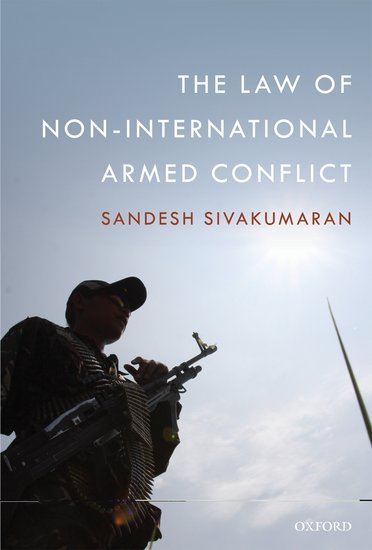By Sandesh Sivakumaran
The last couple of years have been bad for journalists. I’m not referring to phone-hacking, payments to police, and the like, which have occupied much attention in the United Kingdom these last months. Rather, I’m referring to the number of journalists who have been killed in wartime.

Why are journalists targeted?
Journalists play a critical role in wartime — reporting on events, revealing the horrors of war, investigating abuses by the parties. Their role is a particularly important one given the fog of war. It’s often through media reporting that the public takes notice of a situation and the international community is pushed into action. For these very reasons, journalists are not infrequently viewed as a thorn in the side of the government or the armed group. They may be considered unwanted witnesses to what is going on and targeted for their reporting.
How does the law of armed conflict protect journalists?
The law of armed conflict distinguishes between different types of journalists:
- Journalists who work for media outlets or information services of the armed forces.
- Journalists who accompany the armed forces and are authorized to do so, but who aren’t members of the armed forces, e.g., the embedded reporter.
- Journalists who are undertaking professional activities in areas affected by hostilities but who aren’t accompanying the armed forces, e.g., the broadcaster who is presenting from a conflict zone but who isn’t embedded with the troops.
The first category of journalists constitutes members of the armed forces. Accordingly, they don’t benefit from the protections afforded to civilians and their deaths don’t constitute a violation of the law.
The latter two categories of journalists are civilians. Accordingly, they can’t be attacked, unless and for such time as they take a direct part in hostilities. Reporting on events and investigating abuses committed by the parties can never constitute taking a direct part in hostilities, even if the investigations lead to greater support for one side or another.
Journalists may, however, prove to be casualties of lawful attacks. This is a particular risk for journalists who are embedded with troops. The law allows for the targeting of troops and that targeting may result in bystanders or embedded reporters becoming casualties. In order to judge the legality of such an attack, the law utilizes the principle of proportionality, ie we have to weigh up the expected loss of civilian life, injury to civilians, and damage to civilian objects with the concrete and direct military advantage anticipated. Only where the former is excessive when compared to the latter will the attack be unlawful. Although any loss of life is regrettable, the legal test means that deaths don’t necessarily imply that unlawful acts have been committed.
Particular controversies
One particularly controversial area of the law is the targeting of TV and radio stations. Civilian broadcasting services are protected from attack. They may be legitimate targets, however, if they constitute military objectives. In legal terms, this refers to objects that, “by their nature, location, purpose or use make an effective contribution to military action and whose total or partial destruction, capture or neutralization, in the circumstances ruling at the time, offers a definite military advantage.”
This would render dual purpose broadcasters that broadcast civilian programmes and which are used for military communications possible targets. Civilian broadcasters that broadcast propaganda are not generally considered military objectives, as propaganda doesn’t satisfy the test for a military objective. Thus, following NATO’s targeting of the RTS studio in Belgrade during the conflict in Kosovo, the Committee established by the Prosecutor of the International Criminal Tribunal for the former Yugoslavia to Review the NATO Bombing Campaign against the Federal Republic of Yugoslavia noted that, “if the attack on the RTS was justified by reference to its propaganda purpose alone, its legality might well be questioned by some experts in the field of international humanitarian law” (para. 76). Compare that to Radio Mille Collines, the broadcaster that was inciting genocide in Rwanda and which many people consider a legitimate target. The dividing line is a tricky one to draw.
Sandesh Sivakumaran is Associate Professor and Reader in International Law, University of Nottingham. He is the author of The Law of Non-International Armed Conflict (OUP, 2012), co-editor of International Human Rights Law (OUP, 2010) and recipient of the Journal of International Criminal Justice Giorgio La Pira Prize and the Antonio Cassese Prize. He advises and acts as expert for a range of states, inter-governmental organizations, and non-governmental organizations on issues of international law.
Subscribe to the OUPblog via email or RSS.
Subscribe to only law and politics articles on the OUPblog via email or RSS.


[…] example of this principle can be seen through Sandesh Sivakumaran’s recent post to the Oxford University Press’s Blog analyzing how the LOAC applies to journalist reporting from an armed conflict. In his post, […]
[…] at the OUPblog, Sandesh Sivakumaran has a post entitled “Killing Journalists in Wartime: A Legal Analysis.” Sivakumaran, who teaches at the University of Nottingham, is the author of The Law of […]
[…] the whole article here. Share this:EmailPrintTwitterFacebookLike this:LikeBe the first to like this. By Hadar Sela […]
[…] Read the whole article here. […]